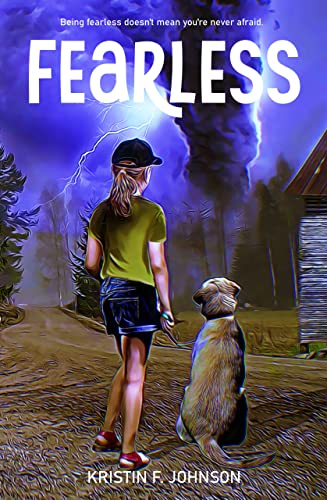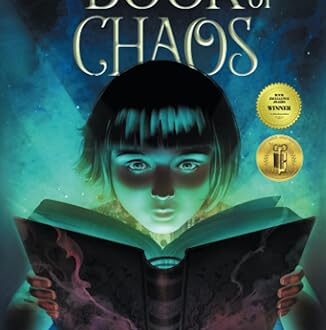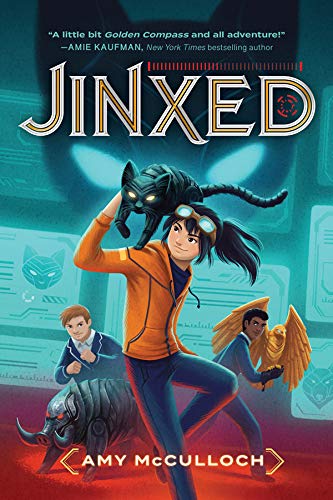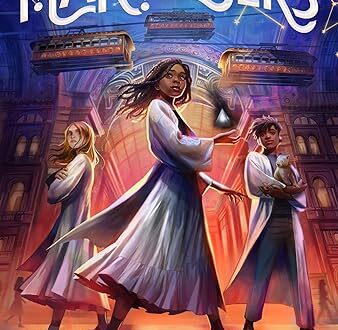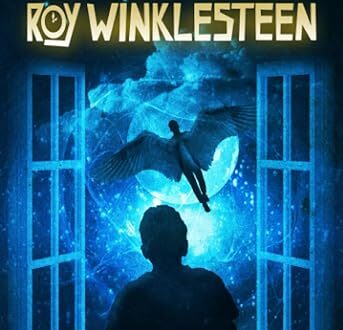-
Fearless: A Dog Story
Eleven-year-old Jessie Nelson fears her soldier Mom won’t make it home from the War in Afghanistan. So, Jessie and her dad move in with Grandpa for the summer in small-town southern Minnesota where a historic tornado has made the townspeople fearful. With new friends in tow, Jessie and the boys stumble onto an old barn with terrified dogs inside. Jessie wants to save them all but knows she can’t. So, she saves one — the one dog cocking its head to the side and watching Jessie with its melty eyes. Soon Jessie learns the dog suffers from PTSD and needs TLC in order to trust again. Jessie hides the fearful dog in her bedroom until another tornado strikes and changes everything.
From author Kristin Johnson for Readers 8-12.
-
Robots–A Kid’s New Best Friend
From science fiction tales to real-life applications, robots have captured our imaginations and are shaping the world we live in. They have been around since the middle of the last century and some of us even have them in our homes in the form of mobile vacuum cleaners. (If your family has one, I bet you didn’t know that it was a robot.)
What is a robot and what is robotics?
First, the modern term robot is derived from the Czech word robota, which means “forced labor” or “serf.” It was first used by Czech playwright Karel Čapek in his 1920 stage play R.U.R.
A robot is any automatically operated machine that replaces human effort. Robots come in many different shapes and sizes from very tiny to very large. One of the most famous robots that you know about is the Mars Rover. It is collecting and analyzing samples, along with data, from the Red Planet and transmitting the information back to us here on Earth.
The car industry is one of the biggest, and longest, users of robots in their assembly plants. In fact, robotic arms assembled most of your family’s car on the assembly line.
Robotics, on the other hand, is the engineering and research that deals with the design, construction, and operation of robots. Engineers, coders, designers, and even kids are involved in robotics today.
The first common robots were the mechanical assembly arms used in the manufacturing assembly line. But today we have far more human-like robots to help and entertain us. They range from droids, like C3PO in Star Wars, to combat drones being used in the war in Ukraine.
The word droid comes from the term android. A droid is a robot with some physical resemblance to a human, like C3PO. While an android is a robot designed to look and act like a human, like the Terminator. (Okay, the Terminator started out acting like a “evil human.” But eventually he turned out to be a “good” guy by helping the heroine.)
Thanks to the lightning-fast advances being made in computer processors today. Robot development is making great strides towards becoming more and more human-like. Especially when they are paired with artificial intelligence.
Like computers, robots are becoming so commonplace in our lives that we are learning about them in school where kids are learning about robotics. Because STEM literacy is so important nowadays in our lives, students are encouraged to start learning about robotics as early as possible.
Robotics can help you gain skills like coding, problem-solving, communication, teamwork, and creativity. It provides you with the skills needed for almost any kind of education or job that you might want to pursue when you get older.
Some people are afraid of robots because they fear that, along with A.I., they will some day take over the world and enslave humans. But, like A.I., it is our responsibility as their creators to teach them how to get along with us.
Besides being helpful, robots can entertain and amuse us as toys, TV shows, and movies. To get an idea of what is out there, all you have to do is a computer search for “robots.” It is interesting and fun to see what is out there already. And to imagine just what kind of new robots the experts are going to come up with in the future.
Who knows? Your robotics classes could lead to you inventing the next great robot.
AIME
-
Secret Agent 6th Grader: Selfies Are Forever
The name’s Valentine, Brody Valentine, and I’m back with my fourth case. The sixth graders of Buchanan School are on a trip to the mall to watch our award winning show choir perform in the food court. Sounds like a pretty sweet gig, right? Not when there’s danger lurking in the background. Someone’s decided to use this trip to string along the last members of Glitch by forcing us on a wild selfie chase, but as it turns out, that was just the tip of the iceberg. Now, one of the best days of the school year is in danger of becoming one of the worst. If I want to keep Glitch alive, I’ve gotta try and solve this case before the show choir takes the stage, but in a case with more twists than a pretzel, things might knot work out for anyone… and they might feel a little salty… and these puns are kind of cinnamon crunchy… wait, that last one didn’t work.
From authors Marcus Emerson and Noah Child for Readers 8-12.
-
Machu Picchu—Mysteries of the Lost City
This ancient Incan city is hidden amidst the lush greenery and the towering peaks of the Andes Mountains. It isn’t just a collection of ruins; it’s a testament to the ingenuity and brilliance of an ancient civilization. And it has captured the imaginations of people around the world.
Here’s a cool fact about the discovery of this lost city—the place probably would never have been discovered without the help of a kid just like you. You see, after two years of research to pinpoint the location of the “Lost City of the Incas” and raise money for his expedition, intrepid American historian and explorer Hiram Bingham set off into the Peruvian jungle in 1911 with nothing more than an educated guess as to where it might be. He eventually only found the spot with the aid of an 11-year-old Quechua Indian boy.
Upon discovering the site, Bingham wondered, “What could this place be?” A century later, we still don’t know why they constructed this place on a spot that practically touches the sky. Nobody is quite sure when Machu Picchu was first built—educated guesses put it at around 1450—or why it was abandoned a century later. Researchers still aren’t sure what its original function might have been—a place of worship, a royal estate, an astronomical observatory? And nobody can say with any certainty what became of its original inhabitants.
The Inca were the end result of 5,000 years of a civilization that started at the same time as Egypt and Mesopotamia. Because of conquest and disease, however, they were only around for 100 years. But they left behind this undisturbed site that is just incredible.
About a third of the ruins have been reconstructed. And it’s easy to imagine how the city must have looked in Inca times, clinging to the top of an emerald green mountain ridge in the rain forest. The site comprises a main plaza—flanked by stone homes, temples, workshops, bathing areas, and a royal palace, surrounded by stone terraces where maize and other crops were grown. Estimates put the population at no more than 1,000 at any given time. Although the reconstructed temples are the most impressive buildings, Machu Picchu’s most important structure is the Intihuatana or “hitching post of the sun,” a mysterious abstract stone construction that ancient priests may have used to study the heavens and make astrological predictions.
At the Temple of the Condor, you can see how the large stone in the middle of the structure has been carved to resemble the head and neck feathers of a huge Andean bird, and how the rocks behind are shaped into outspread condor wings. And gazing down on the Temple of the Sun, you can see the Serpent Window, which, according to legend, was used to admit snakes to the shrine.
Even without knowing the background, cosmology (cosmology is the study of the origin and development of the universe), or history of the Inca and Machu Picchu, it is incredibly impressive. The more you observe and see, the more you wonder about it. How did these people do this? And why?
Machu Picchu was built on two fault lines, so it is no stranger to earthquakes. When one occurs, the stones bounce like they are dancing and then fall back into place. It is because of this engineering feat that the site still stands today.
Some more interesting facts about the place. More than a hundred skeletons were found at the site. Today, we now know that they were close to evenly split between women and men.
Hiram Bingham thought he had discovered the Lost City of Vilcabamba, even though we now know it was Machu Picchu. Unbeknownst to him, he had also traveled through Vilcabamba in 1911.
Machu Picchu is built on a mountain ridge that is 7,970 feet high (2,430 meters). 5,280 feet equals one mile. So, Machu Picchu is almost 1 and one-half miles high. Think how long it would take you to hike all the way to the top of that mountain ridge since it is almost straight up in the air. That’s a lot of climbing to do.
AIME
-
Jinxed
The Golden Compass meets the digital age! When a coding star enters an elite technology academy, she discovers a world of competition, intrigue, and family secrets—plus a robotic companion that isn’t what it seems.
Lacey Chu is a girl who codes. She has always dreamed of working as an engineer for MONCHA, the biggest tech firm in the world and the company behind the “baku”—a customizable “pet” with all the capabilities of a smartphone. But when Lacey is rejected by the elite academy that promises that future, she’s crushed.
One night, Lacey comes across the broken form of a highly advanced baku. After she repairs it, the cat-shaped baku she calls Jinx opens its eyes and somehow gets her into her dream school. But Jinx is different than any other baku she’s ever seen…He seems real.
As Lacey settles into life at school, competing with the best students in a battle of the bakus that tests her abilities, she learns that Jinx is part of a dangerous secret. Can Lacey hold on to Jinx and her dreams for the future?
From author Amy McCulloch for Readers 9-12.
-
Hiking–Exploring Nature’s Playground
The warm sunshine on your face, the sound of the wind rushing through the trees overhead, and the soft earthy feel of the trail under your boots. Not only are these experiences enjoyable to have, but they’re good for you, too. Hiking offers physical exercise and emotional relief.
Hiking is one of the best ways to get exercise. Whether you scramble up a steep incline or are walking on a winding dirt path, hiking is the perfect opportunity to get a workout!
Being in nature can boost your mood and improve your mental health. Spending quality time in the great outdoors reduces stress and calms anxiety. Hiking, taking in the sights and smells of nature, is good for you.
Hiking with a friend or a group of friends is fun. And the fun fact is that you can hike just about anywhere, as long as you are careful and tell others where you are going. The opportunities and benefits of hiking are waiting for you. All you have to do is go.
To get started, you need to choose the right hike. And you need to be aware of some safety tips when you are going on an extended Nature hike.
The first step to pleasurable hiking is gauging your physical limits and choosing a trip to fit your physical abilities. Key factors to consider are distance, elevation change and the type of terrain.
If you’re a newbie, start with short, simple walks and work your way up. If possible, hike with a companion or in a group with more experience. Not only will it be safer and more fun, you can share in others’ knowledge and skills. Clubs and guided walks are also great ways to learn the basics.
For the more adventuresome among you—consider going on longer hikes in Nature. For those of you who want to venture away from your city with its parks and hiking paths, here are some safety tips you will want to consider. But, whatever you do, just make sure that you let somebody know where you will be hiking and when you expect to return. Plus, do not hike alone. Just in case an accident or a serious incident happens to you while you are out hiking, a companion can help save your life by getting help for you.
To begin your long hike, start by wearing layered clothing to protect yourself from the elements and to help regulate your body temperature. With layered clothing, you can add or subtract as needed. A dependable waterproof jacket is vital, of course. As is a hat—broad-brim for sunny days, a woolly hat for the cold. The general rule of thumb is always to be prepared for the worst conditions.
So, pay attention to the weather.
Choose good boots—your feet and ankles will thank you. So will your back and the rest of your body.
Carry a comfortable backpack. If you’re going to carry a heavy load for long periods, get a backpack with a good harness. A properly fitted backpack allows freedom of movement, but doesn’t swing from side to side.
Pack lightly for long hikes, including lightweight food in plastic bags. Also, make sure you have water. Food is your fuel, so pack foods that are high energy and nutritious. Tasty treats such as chocolate can also work wonders.
Pace yourself. Enjoyable hiking depends on endurance, not speed. Take regular rest stops to take the weight off, rehydrate, and nibble some nuts—three moves guaranteed to keep you smiling.
AIME
-
Epic Kids
Jake is an average, unpopular kid at school, and is shocked when the cool new kids ask him to sit with them at lunch. They’re not what he expected – a monstrous boy named Darryl levitates a lunch tray above his head, and a mysterious girl named Amanda shoot green bolts of lightning from her fingertips.
Jake is soon on a mission to prove he’s anything but average when it’s revealed he’s from another planet and has a duty to protect Amanda. He helps his new friends as they’re hunted by a dangerous, very-much alive mechanical dinosaur. And that’s just to start with. Jake learns that he has powers of his own (that involve a hidden door with glowing light) and will do everything he can to keep his new friends safe.
From author David Blaze for Readers 9-12.
-
Ghosts—Are They for Real?
Is “Bloody Mary” in your school’s bathroom?
Mary is a blood-covered ghost who is said to have murdered her three children with a knife. To find out if she is there or not. All you have to do is to go into the bathroom by yourself and turn out the lights. Then look in the mirror and summon her by saying her name three times in a row—Bloody Mary. Bloody Mary, Bloody Mary.
If she is there—and wants to come out—you will see her staring at you over your shoulder, in the mirror.
Most kids who have seen her have been so frightened by the sight of her. They fled the darkened bathroom before they could think to look and see if she still had the bloody knife in her hand.
When we think of ghosts, we don’t normally think of a ghostly seventeenth-century wooden merchant ship. But one of the most famous ghosts in the world is just that—a ghost ship, The Flying Dutchman.
She is known as the Flying Dutchman because of her Dutch captain, Hendrick van der Decken. He refused to seek safe harbor during a violent storm while navigating the Cape of Good Hope, despite pleas from the crew and passengers. Instead, the impudent captain challenged God to take them down. The ship was promptly cursed and in its ghost form is damned to never find port again. As a result, she has been haunting the seas since the 1600s.
Ships’ crews and passengers from all over the world have reported seeing her over the years. She often appears as a hazy image or as a strange light and is strongly believed to be the omen of bad luck and doom. Her last reported sighting was off the coast of South Africa.
So many people have reported seeing her over the years that Walt Disney Studios used her in a movie. They called it “Pirates of the Caribbean” and in the movie Davy Jones captained her.
Among suspicious sailors, Davie Jones was thought to be the deity of death and his “locker” was the final resting place of dead sailors. In Disney’s movie franchise he is featured as the undying evil spirit that collects the souls of the dying pirates while traveling in his legendary ship “The Flying Dutchman,” and his locker was portrayed as a sort of purgatory for the dead souls.
In a suburb of Chicago lies an abandoned cemetery that is believed to be extremely haunted. It’s known as Bachelor’s Grove and a wooded nature reserve surrounds it. Until the 1960s, for over one hundred twenty years, it was used as a local cemetery by the nearby residents before it was abandoned. Nowadays, the local teens use it as a secret party spot—if they are daring enough to brave the woods and the ghosts. Nocturnal visitors have reported sighting featureless orbs of light or blobs of ectoplasm. Many visitors report seeing a spectral farmer and his horse, a vanishing black dog at the cemetery’s entrance, eerie figures in monks’ robes, and a ghost with two heads.
The “white lady,” a ghost in white, is the most renowned ghost in Bachelor’s Grove. She chose to keep her baby even after death. On nights of the full moon, she is seen wandering the graveyard carrying a baby, or apparently sometimes in the full daylight sitting on a tombstone.
If you were a teenager from Chicago, would you be brave enough to go creeping around that cemetery at night? Or any cemetery at night?
Now we know ghosts like to haunt houses. And one of the most famous haunted houses is in a small town called Amityville on New York’s Long Island, where the Lutz family lived. Soon after they moved into the house, weird stuff started happening. Like voices yelling at priests, flies swarming in the house even in winter, cold spots, and unpleasant smells. They also experienced vivid nightmares, a rotating crucifix, physical attacks on the family, and appearances by a freaky pig monster named Jodie. After many other experiences like that, the Lutzes abandoned the house and left their possessions behind. Jay Anson wrote a book about their terrifying experience which was known as “The Amityville Horror” and Hollywood made a movie of the book.
What about you? Have you ever seen a ghost? Or known someone who has?
AIME
-
Brainwashed: Crime Travelers Spy School Mystery & International Adventure Series Book 1
While sleeping on the roof of his father’s hotel-spy school, thirteen-year-old Lucas Benes finds a baby alone and learns that the Good Company has restarted its profitable brainwashing business. The first book in the trilogy tracks the secret urban adventures of international teenage spies. Lucas, the reluctant hero, leads a group of friends through the hotspots of Paris-from the catacombs to the Eiffel tower–in an all-out effort to sabotage a brainwashing ceremony that could potentially turn them all into “Good” kids.
From author Paul Aertker for Readers 9-12.
